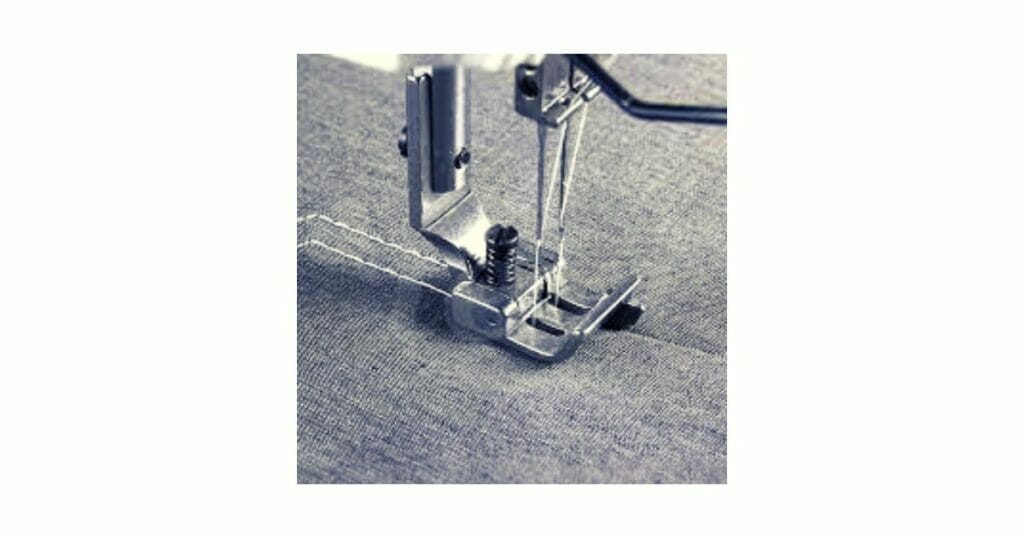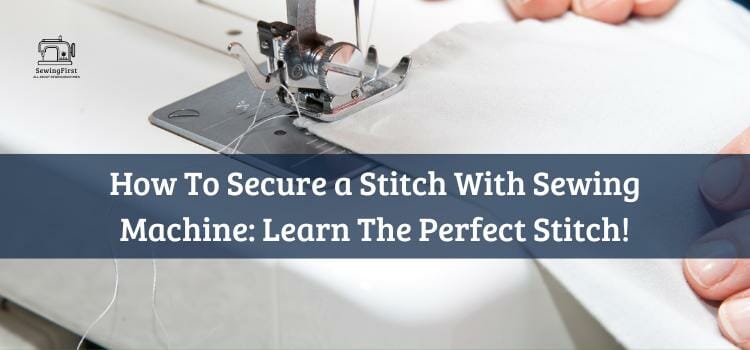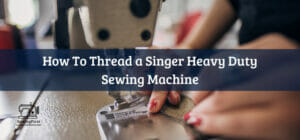Securing a stitch with a sewing machine is like constructing the walls of your castle – it’s essential to protecting what you cherish. Whether you’re making clothes, accessories, or decorations for your home, having secure stitches will make sure that everything stays together and looks great.
In this article, we’ll discuss how to secure a stitch with sewing machine no matter what project you’re tackling.
Once you have the correct needle and thread, set up your machine correctly by adjusting the tension setting according to the instructions included in its manual. This will ensure that every stitch is held securely as it’s made.
When ready to sew, choose an appropriate stitch length based on the thickness of the material you are working with; thicker materials usually need longer stitches while thinner ones should use shorter stitches for better security.
Related Topic: How To Back Stitch On A Singer Sewing Machine: The Easiest Way – 2023
Table of Contents
ToggleGetting Started
Securing a stitch with a sewing machine doesn’t have to be intimidating. With the right tools and some basic knowledge of your machine’s features, you can confidently tackle almost any project. Let’s start by discussing what supplies you need for this task.
When it comes to stitching, the most common type is a straight stitch. You’ll also want a presser foot that fits securely on your machine and allows for even stitches every time.
Don’t forget about thread—you should use quality spools of thread in matching colors when possible. Make sure that the bobbin threads match too! Lastly, don’t overlook the importance of having enough thread tails for knotting.
Now that we’ve gone through all the necessary items, let’s move on to the next step: threading your machine.
Threading The Machine
Threading a machine is the next step to securing your stitches. To get started, you’ll want to make sure that the needle thread matches the type of fabric you’re working with and that it is secure in the spool before inserting it into your machine.
Then, thread the line of thread through each of the guides on your sewing machine until you reach the needle. Be sure to pull out enough length so that there’s plenty for knotting later.
Once everything is threaded correctly, double-check to make sure all lines are even and smooth—if not, go back and rethread until they look perfect! It’s also important to note here that different types of threads require different tensions when being used; be careful not to set too tight or too loose of tension as this can cause skipped stitches or unevenness.
Finally, once you have made sure everything looks good and flows properly, give yourself a pat on the back—you’ve just completed one part of setting up your machine! Now we move on to setting up our bobbin ready for stitching.
Setting Up The Bobbin
Now that the machine is threaded, it’s time to set up the bobbin. This part may seem a bit intimidating at first but don’t worry—with just a few simple steps you’ll be ready to go!
First, make sure your sewing machine has its default settings for stitches per inch and tension. Then, place the bobbin into the bobbin case with the thread going in the same direction as indicated by the arrow on most machines.
After this step is complete, pull out about 6 inches of thread from the front side of your machine so that you can tie it off later when needed.
Finally, insert your bobbin case back into its proper position inside your sewing machine while making sure no extra threads are caught around any parts or spindles. If everything looks good here then you’re now ready to start stitching away!
Choosing The Right Needle & Thread
Once you have the bobbin set up and ready to go, it’s time to choose the right needle and thread for your project. This is important because different types of sewing require different types of needles and threads. For instance, a thicker thread would need a larger, heavier-duty needle so that it can feed through the fabric without breaking or fraying.
You’ll also want to consider what type of stitch you are looking to use when selecting the appropriate needle as well—straight stitches will usually be done with a universal or denim needle while zigzag stitches may require an embroidery or stretch needle depending on the project.
When choosing your machine stitching thread, make sure it matches both your fabric weight and color. Additionally, try not to pull too hard on the raw edges of any material as this could cause them to unravel over time due to excessive tension from the spooling process.
Lastly, remember that some machines come equipped with adjustable feed dogs which allow for more precise adjustments in order to get exactly the look you’re going for!
Identifying Types Of Stitches
Now that you have the right needle and thread selected, it’s time to learn about identifying different types of stitches. Whether you’re a beginner or an experienced sewer, there are some common stitches every seamstress should be familiar with. Here is a list of five popular machine stitching techniques:
- Zigzag stitch – A zigzag stitch is typically used when sewing stretchy materials where you need extra elasticity in your seams. It’s also commonly used for decorative purposes like applique or embroidery.
- Normal stitch – Also known as straight stitch, this is the most basic type of machine stitching and can be used for any project from hemming pants to attaching buttons.
- Reverse stitch – This technique involves repeatedly backstitching over a few inches of fabric in order to secure the edges more tightly than normal stitching would allow.
- Medium stitch – This type of machine sewing uses longer stitches than normal stitching but not quite as long as reverse stitching. It’s great for reinforcing areas that tend to bear heavier wear-and-tear such as elbows on jackets or pockets on jeans.
- Common stitch – This style of stitching is basically a combination of normal and medium stitches; its length sits somewhere in between those two techniques which makes it ideal for general-purpose projects.
Knowing how to identify these common types of stitches will help you make better decisions while creating garments and accessories! With a bit of practice, you’ll soon become comfortable with selecting just the right one depending on what look you’re going for—whether it’s something simple like a plain topstitch or something fancy like an intricate buttonhole pattern.
Selecting A Stitch Length & Width
When it comes to securing a stitch with a sewing machine, there are several key factors to consider. According to one survey, 84 percent of sewers believe that selecting the correct length and width for their stitches is the most important factor in achieving successful results. With this in mind, here are four tips for choosing the right stitching specifications:
- Pieces of fabric – You’ll want to make sure your stitches aren’t too long or wide as this could cause puckering along the seam allowance. It’s best to have shorter, narrower stitches when working with delicate fabrics like silk or chiffon.
- Seam allowance – The standard seam allowance for sewing machines is 5/8 inches (1.6 cm). This will give you enough room to turn out finished seams without having them look bulky. Remember that if you need more space, you can always use a wider seam allowance.
- Reverse button – Most modern machines come equipped with a reverse button which allows you to backstitch over each side of the seam before ending off with a couple of stitches at the end. This adds extra security so that nothing unravels after washing and wearing your garment multiple times.
- Delicate fabrics – If you’re working on something made from a lightweight material such as voile or organza, it’s essential that you don’t pull the fabric too tightly while feeding it through your machine. Otherwise, there’s potential for distortion along those areas where pressure was applied during stitching.
By taking into account these few simple points about selecting an appropriate stitch length and width for any given project, you should be able to achieve professional-looking results every time! Now let’s move on to adjusting tension settings.

Adjusting Tension Settings
Once you have selected the right length and width for your stitches, it’s important to adjust the tension settings on your machine in order to achieve a neat stitch. Tension is what keeps the excess thread from showing up on either side of the fabric when sewing projects together.
Too much tension can cause puckering or too-tight stitching along seams, while not enough tension may result in loose loops that look unsightly. You’ll want to find a balance between these two extremes so that every single stitch looks exactly how it should.
For most standard fabrics like cotton or polyester blends, setting both top and bobbin tensions at 4 usually works well. However, if you’re using an industrial sewing machine, you will need to consult its manual for specific instructions regarding tension adjustment.
No matter which type of machine you use always tests out any new adjustments before starting work on actual pieces of fabric. This way, you can make sure everything looks perfect before taking the time to sew together all of the components of your project!
Practicing On Scrap Fabric
Of course, it’s not enough to simply know how to adjust the tension settings on a sewing machine. To ensure that every stitch is secure and looks perfect, you must also practice your technique. After all, even with proper tension adjustment, extra stitches or inconsistent seam allowances can still occur if the user isn’t careful.
So before starting any project, take some time to practice stitching lines on scrap fabric. This will help familiarize you with the feel of the machine and give you an idea of how much pressure to use when guiding fabrics through under the needle. It’s especially important for those who are new to sewing or using heavier fabrics like denim or canvas.
Here are some tips to keep in mind while practicing:
- Always start at least two inches away from any edges so that you make sure each previous stitch was secured correctly.
- Don’t be afraid to backtrack over sections if needed; this helps keep everything neat and consistent.
- Pay attention as you go along so that seams line up properly and don’t become crooked due to too much pressure being applied in one direction.
By taking these steps, you can build confidence in your skills and create beautiful projects with clean lines!
Sewing In Reverse To Lock A Stitch
To ensure that a row of stitches is secure, many sewers use the reverse stitch. This technique involves going over your seam in the opposite direction while using extra pressure to lock each stitch into place. It’s especially useful when working with fabrics like sheer fabric or any other lightweight material that may be prone to unraveling.
Begin by stitching forward until you reach the end of your seam line, then backstitch once more for added security before starting on the next section. You can also adjust the length and width settings on your machine so that each backward pass is longer than its counterpart – this helps prevent unsightly loops from forming at the top edge of your work.
If you make a mistake along the way, don’t panic! A seam ripper will easily remove unwanted stitches without leaving behind any evidence; just make sure to keep it away from the throat plate as much as possible since it could potentially damage delicate parts.
By taking these steps, you’ll have no problem locking down seams and securing them against future wear and tear.
Finishing Seams With Specialty Feet
Now that you have a better understanding of how to secure a stitch with a sewing machine, let’s take a look at how specialty feet can help finish seams. These additional tools provide an extra layer of security and give your finished garment or project some added flair!
One such tool is the blind hem foot. This specialized attachment helps create perfect hems without any visible stitching on the right side of the fabric. It does this by picking up small sections of material as it moves along – giving off the illusion of one continuous line when complete.
Another great option is the edge-stitching foot; this foot provides evenly spaced stitches along edges while keeping them perfectly aligned. Not only does it make finishing seams easier, but it also adds texture and definition to otherwise plain fabrics.
These two feet will ensure that no matter what type of project you’re working on, all of your stitches are securely locked in place for years to come – providing safety and peace of mind for both you and your work.
Troubleshooting Common Issues
No matter how well you know your sewing machine and its many attachments, every once in a while you may run into some hiccups. Whether it’s an uneven stitch or an unraveled seam, there are several common issues that can occur during the stitching process. Let’s take a look at what to do if one of these problems arises:
- If you notice any skipped stitches or loops on the underside of the fabric, check to make sure all thread guides are properly aligned and tension is set correctly. You may also need to replace the needle with a new one that fits your project best.
- If threads start bunching up beneath the fabric, then most likely you need to adjust the bobbin tension for smoother results. Check out our guide for more information about this process!
- Finally, keep an eye out for broken needles – they can cause serious damage if left unchecked. To prevent this from happening again, change out your needle regularly and use appropriate pressure when working with heavier fabrics.
With these tips in mind, you should be able to troubleshoot any minor difficulties that come up as you sew – ensuring everything comes together perfectly each time! Now let’s move on to repairing a broken stitch or seam.
Repairing A Broken Stitch Or Seam
Stitches and seams can become broken for many reasons, from a needle that’s dull or too small to fabric that has been stretched too tightly. But it doesn’t have to be the end of your project! With a few simple steps, you can get back on track in no time.
First things first: assess the damage. Take note of any snags or unraveled threads so you know exactly what needs to be repaired. Then slowly unpick the broken stitch with a seam ripper – try not to pull at long strands as this could create more damage.
Once all faulty stitches are removed, use a hand-sewing needle to resew the area using an overcast stitch or blanket stitch – both will provide extra strength and durability for the repair job. Be sure to use thread that matches the original color of the fabric for the best results!
TIP: If you don’t feel confident enough doing this by hand, simply set up your sewing machine again and sew along the same line as before; this should cover up any signs of repairs while also providing added security against future wear and tear.
With these tips in mind, you’ll be able to easily fix any broken stitches or seams without having to start all over again – leaving you free to continue creating something beautiful!
Maintaining Your Sewing Machine
Maintaining your sewing machine is essential to keep it in perfect condition and ensure that all stitches remain secure. Here are a few tips to help you get the most out of your machine:
To start, be sure to regularly clean and oil the parts. This will prevent any dirt build-up or rusting which could potentially affect the quality of workmanship.
Additionally, always use high-quality thread as this will make for smoother stitching with less risk of breakages or snags – plus it’ll last longer too! Finally, never leave the needle down when not in use; this can cause excessive strain on the fabric and could even damage the material itself if left unattended.
By taking good care of your equipment, you’ll have confidence that each stitch remains strong and secure – allowing your projects to look their best for years to come!
Conclusion
In conclusion, sewing with a machine is an art form that takes time and practice to learn. With the right setup, you can create beautiful projects from home. Each type of stitch has its own purpose and it’s important to know when each one should be used for the best results.
Using specialty feet can help finish seams more quickly and efficiently than standard stitching techniques. Troubleshooting common issues like broken stitches or jammed machines can save time in the long run – plus, having knowledge on how to repair them yourself helps keep your machine running smoothly!
FAQs
How do you secure a sewing stitch?
To secure a sewing stitch, you can tie a knot at the end of the thread, or you can backstitch at the end of the seam.
How do you do a lock stitch on a sewing machine?
A lock stitch on a sewing machine is made by setting the machine for a straight stitch and then setting the stitch length to 0. This creates a stitch that is locked in place without the need for a backstitch.
How do you do a lock stitch on a sewing machine?
A lock stitch on a sewing machine is made by setting the machine for a straight stitch and then setting the stitch length to 0. This creates a stitch that is locked in place without the need for a backstitch.
To finish the seam, take a few stitches in the same direction and then reverse the stitch direction to lock the stitches in place.
What is the most secure stitch on a sewing machine?
The most secure stitch on a sewing machine is a lock stitch. This stitch is created by the sewing machine using two threads, one in the needle and one in the bobbin, which loop together at the same time to create a secure stitch.
How do you secure a stitch without a knot?
You can secure a stitch without a knot by using a loop stitch. To do this, insert your needle into the fabric and pull the thread through. Then, reinsert the needle into the first stitch, create a loop with the thread, and pull the needle and thread through the loop. Finally, pull the needle and thread tight and repeat the same process for each stitch.
How do you secure a stitch without backstitching?
Secure a stitch without backstitching by looping the last stitch through the fabric and tying off the thread with a knot.





